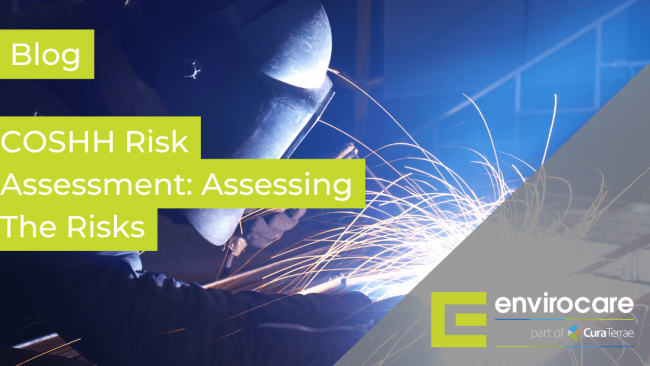COSHH Risk Assessment – Assessing The Risks
2 December 2015

What Is A COSHH Risk Assessment?
A COSHH (Control of Substances Hazardous to Health) risk assessment will identify substances and activities where there may be exposure to hazardous substances, used or generated, which may damage health. It’s about taking sensible steps to prevent ill health to employees and visitors. The aim of an assessment is to know how workers are exposed, what they are exposed to, and finally, what is the probability of adverse health effects arising from exposure.
The COSHH regulations require all employers to assess the risks to health arising from hazardous substances created by the work activity, and then decide what precautions are needed in order to prevent or adequately control exposure to these hazards.
A COSHH risk assessment is a thorough look at your workplace to identify all situations, products and processes that may cause harm. After these have been identified, it is time to evaluate how likely and severe the risk is, and then decide what measures should be in place to effectively prevent or control the harm from happening. This could be by eliminating exposure by using a non-hazardous alternative or to reduce exposure below the Workplace Exposure Limit.
Although not specifically part of a COSHH risk assessment, consideration should be given to the possible environmental impact of the use and disposal of any chemical.
Is the activity safe to operate, does it need improved control measures (such as PPE or ventilation) and is it a significant hazard to health to warrant special containment?
Identifying The Risks and Hazards
Please remember that health hazards are not limited to substances labelled as ‘hazardous’. There are also many harmful substances that can be produced by the process you use, including silica dust from tile cutting, wood dust from sanding or even isocyanates from vehicle spray repairs.
In order to identify hazards you need to understand the difference between a ‘hazard’ and ‘risk’. A hazard is something with the potential to cause harm, and a risk is the likelihood of that potential harm being realised.
Hazards and risks can be identified by using a number of different techniques:
- Walking round the workplace and observing processes
- Looking at accident, incident, or near-miss records
- Reading product labels and safety sheets
- Speaking to an independent consultant
- Contacting the substance supplier
- Asking your employees, as they may be able to express concerns regarding issues not picked up by any H&S inspections
Overall, the goal is to find and record possible hazards that may be present in your workplace. It is advised to include both people familiar with the work area and people who are not. This way you have both fresh and experienced eyes conducting the inspection.
Decide Who Might Be Harmed and How
Once you have identified the potential hazards and risks, you need to understand who might be harmed and how this may happen. This includes people working in the warehouse, visitors or members of the public:
- Think about how people may be exposed via ingestion or inhalation, and the effects of this exposure
- Think about anyone else who could potentially be exposed, such as cleaners or maintenance workers
- Think about how long and how often people work with or are surrounded by the substances
Assessing The Risks
Sometimes it can be easy to judge the amount of exposure to substances and decide on what steps are necessary in order to control it.
If small amounts of materials are used (harmful or not) and there is very little chance of it escaping, the risk can be considered low. But in a different task/process involving the same material (cleaning and disposal) the risk could be a lot higher due to more chance of the harmful substance getting onto the skin or being breathed in.
If a task involves a larger amount of material, with obvious leaks, exposure is higher and of course, so is the risk. Whether the substance is harmful or not, your need for control is obvious. You then need to decide what measures need to be taken and when.
If you have five or more employees, you must record your COSHH risk assessment but, even if you have fewer than five, it is advised to still write down what steps you have taken to identify the risks. The most important part is to make a list of actions you are taking to control the risks to employee and visitors’ health.
Workplace Exposure Limits
The Health and Safety Executive (HSE) has established Workplace Exposure Limits (WELs) for a number of substances hazardous to health. These are intended to
prevent excessive exposure to specified hazardous substances by containing exposure below a set limit. A WEL is the maximum concentration of an airborne substance, averaged over a reference period of 8 hours, to which employees may be exposed by inhalation.
You must ensure that workplace exposure limits are not exceeded. Correctly applying the COSHH principles of good practice will mean exposures are controlled below the WEL. All substance approved limits can be found within HSE publication EH40/2005.
Review and Monitor Your COSHH Risk Assessment
It is important to know that your COSHH risk assessment is always complete and accurate. It is essential to review your risk assessment on a regular basis to be sure that nothing has changed and that your control methods are still effective. Triggers for a review can include:
- If there is a change or addition to machinery, tools or equipment
- When new information becomes available about a product
- The introduction of new substances or chemicals
- Moving to a new building, work area or location
- A change in the work process or flow
- If new employees are introduced
- At the start of a new project
COSHH Risk Assessment Procedure
Where a substance requires a COSHH risk assessment, the following procedure should be followed. We will be going into further detail of each of these steps via nine individual in-depth articles:
Understanding – What Is COSHH?
Step 1 – COSHH Risk Assessment – Assessing The Risks
Step 2 – Decide What Precautions Are Required
Step 3 – Prevent or Adequately Control Exposure
Step 4 – Ensure That Control Measures Are Used and Maintained
Step 5 – Monitor The Exposure
Step 6 – Health Surveillance? What Is It?
Step 7 – Prepare A Plan For Accidents and Emergencies
Step 8 – Ensure that you Properly Inform, Train, and Supervise Employees
Experts In COSHH Risk Assessments
Envirocare is a leading Occupational Hygiene and Stack Emissions Testing with over 150 years combined experience.
Envirocare will aid your COSHH risk assessment by carrying out COSHH Air Monitoring to determine the levels of substances in the workplace and ensure the WEL value is not exceeded for the substances you use. We will also provide a detailed report on work practices and findings together with recommendations for remedial action.
Call us on 01274 738668 or fill out our Envirocare enquiry form for any queries regarding this article, COSHH air monitoring, COSHH risk assessments or any of our many other accredited environmental and occupational hygiene services.
